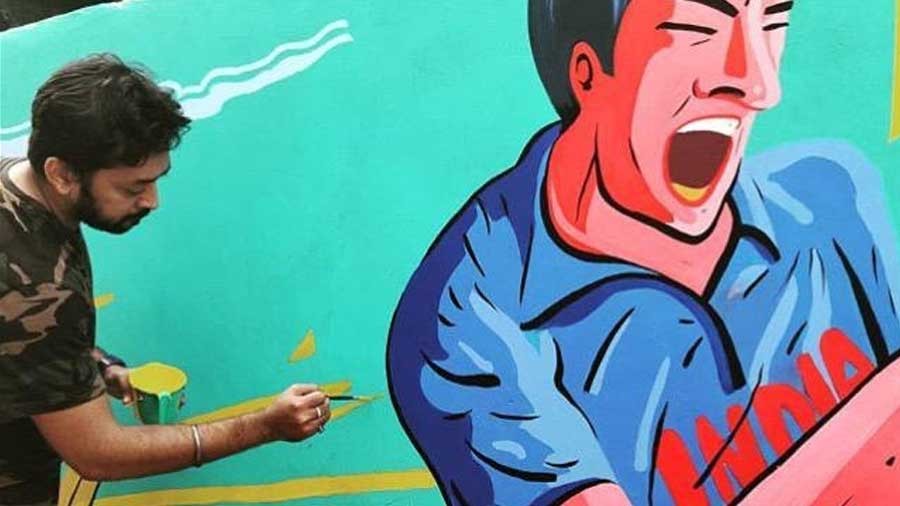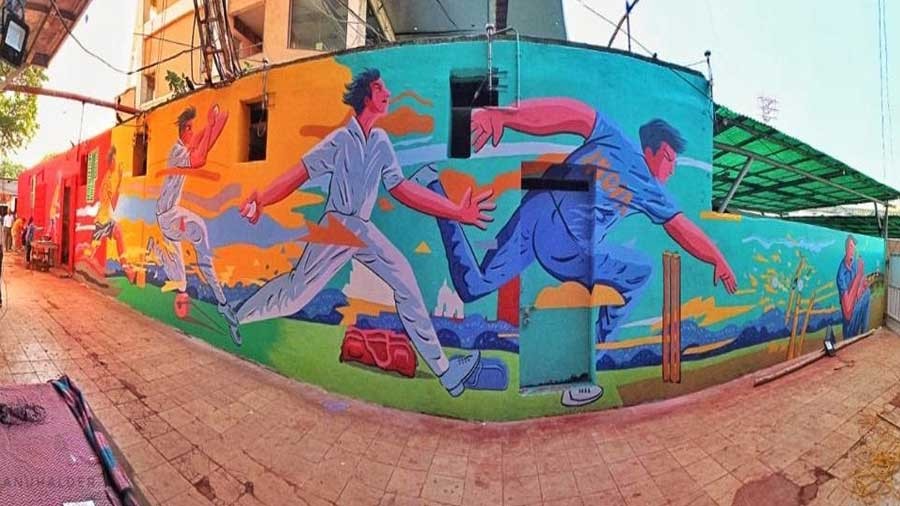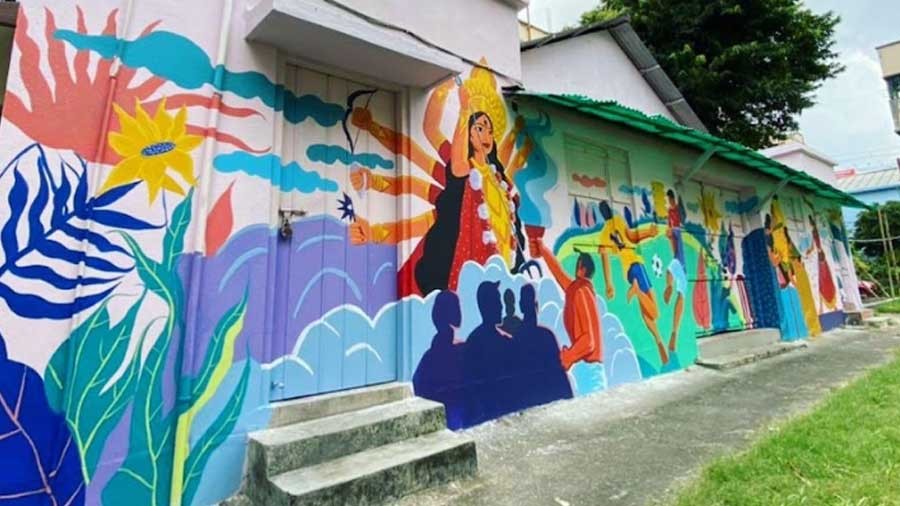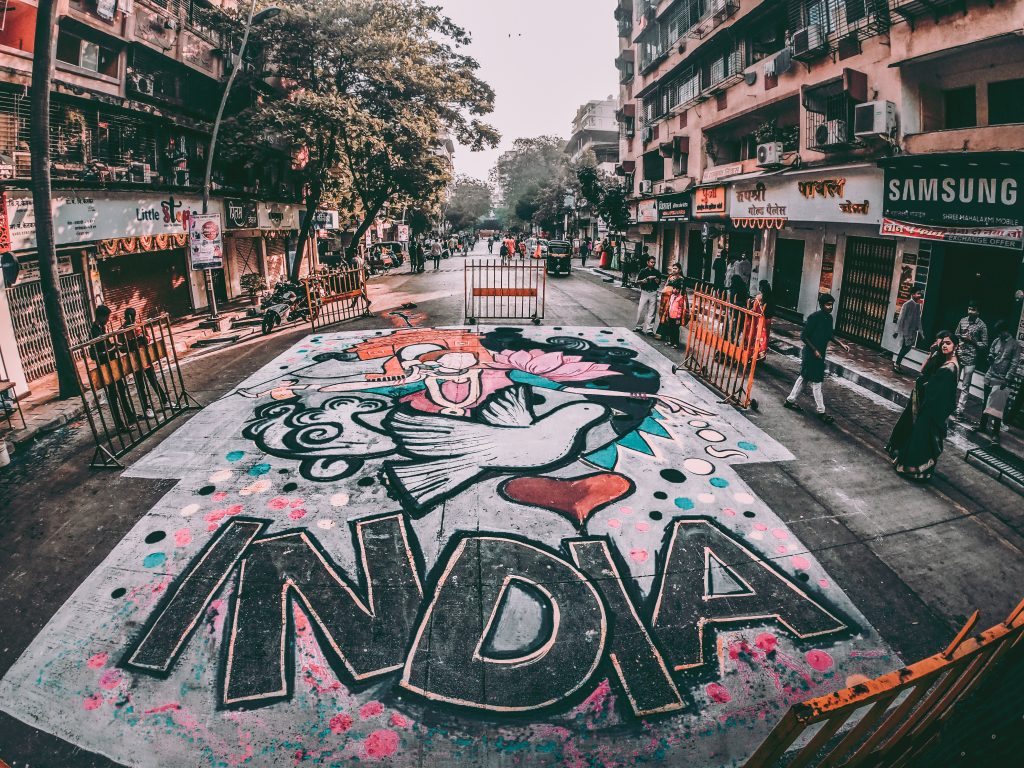This long-read-research article about Street Art- Graffiti in the Indian context brings multi-layer ideas about social life and street art as a context itself. Read the first part of this research article here: Street Art and Graffiti In Indian Public Spaces. Read the Second article: Historical Background of Graffiti and Street Art in India. The third article: The Rise of Street Art. The fourth article: Spatial Interaction of Street Art and Graffiti
Kritika Verma
Vandalism, graffiti or public art?
What is the particularity of urban street art? It is a visual art, imagined, most of the time produced, and exposed in one public space: the street. It carries rebellious, anti-capitalist and anti-consumerist messages typically unauthorised or supported by local governments. These interventions are not for profit, differentiating themselves from corporate art, vandalism and territorialism.
It includes not only more traditional notions of graffiti but many different forms of media and techniques; sculpture, yarn bombing, stickers, mosaic tiling, wheat pasting posters, wood blocking, video projection, flash mobbing, stencils, guerrilla art, street installations, and art intervention; “the work displays a spectrum of uncensored talent that is immediately put in front of an audience, ready to be liked, loved, hated, judged or simply ignored”. Historically, war propaganda from the First and Second World Wars are example of a mode of communication aimed at influencing the attitude of a community towards a cause or position, often used to manipulate human emotions by displaying selective information.
In the 1960s and 1970s, there was a renewed call for freedom of expression in public space, stemming from art and political contestation movements in Europe, “At the time, Europe was undergoing a large number of historic configurations: a return to democracy, the development of artistic practices outside “official art”, a reaction to the industrialisation of the art market and so on”. In the 1980s and 1990s, the popularity of such movements grew, both in the number of festivals, shows, and companies and in public attendance. In the 21st Century, urban street art exploded. Rebelling against consumerism proved an alternative, “street art became a counterbalance to commercial advertising and its assault on consumers”. However, as the floodgates of this visual art opened, its original intention seemed to get lost. This was exacerbated by the proliferation of images through the Internet and adopted by branding, “we used to call ourselves underground, but now it seems like everybody is down here”. No longer pushing the boundaries of the urban experience, many artists began to look in new directions. The visual encounter is changing, considering the multidisciplinary nature of urban street art and these practices’ economic, political and cultural contexts. By adopting new methods and techniques, street art manipulates urban space. Urban street art does not necessarily mean defacing or destruction; something can be added or altered to jolt everyday life. For instance, London’s CutUp was an anonymous collective of art activists who commented on the urban environment by using existing materials on the street, a technique developed by the Situationists known as détournement.
They shared the desire to reorder urban landscapes through intervention and play; by ripping down billboard or advertisements, cutting them into mosaic squares, and reordering them before re-pasting them, CutUp “want to draw attention to the psychological environment that we all inhabit and how the controlled visual elements of the city can directly affect how people feel and think”. In manipulating these images to represent youths and marginalised characters in society, they comment on their role in space, “We felt that they symbolised the isolation and disaffection of society “, they observe, quoting Debord, “His actions are no longer his own but rather someone that represents them to him”. And so, the definition of vandalism blurs. Many who critique the urban street art and graffiti movements often refer to the broken window theory. It argues that if, in one instance, there is a broken window, it increases the likelihood of more broken windows and graffiti appearing. Therefore, the broken window theory is a signalling effect for the urban disorder. While the idea illustrated graffiti as one means of disorder, rather than urban street art per se, it exemplifies the need to control and keep society tidy to maintain order.
Arguably, there are varying definitions of the order itself, but it illustrates a form of tyranny in this case. Whether the line blurs between vandalism, territorialism or art, urban street art itself remain considered a crime in the UK under the Criminal Damage Act 1971, and those intentionally or in the act of graffiti will be prosecuted, receiving a fine and risking imprisonment. However, even with penalties, urban street artists continue to express themselves. The irony is that many street artists become household names, moving from the streets to the exhibition room to the auction house to even the museum; for example, Banksy and OBEY. Some street artists have become brands, while large corporate companies hire others to endorse a new and avant-garde form of advertising. It seems that urban street art is now almost encouraged, in part by companies and tourism boards; street artists are being revered in the street and persuaded into the gallery space, as “many now recognise how square they were in trying to eradicate it.”
An evolving role: street art, visual culture and contemporary society-
Let us return to the arguments proposed by Debord and the Situationists. Even though street art straddles a grey line between legality and illegality, it has become a part of how people shape their urban surroundings. Debord’s idea of the spectacle influences many street artists; “the spectacle is society itself, is part of society and the instrument to dominate society”. The spectacle has many facets, and mass media is only one. Images replace reality and necessitate the passivity and isolation of the individual in society. However, Debord saw that “alternative urban visions have often acted as beacons for exploring the emancipatory possibilities of life in the present and breaking through to new and better futures”. One such urban vision was to create a new situation that unified art and life outside of the spectacle, moving beyond art governed by it, “If the non-intervention sums the spectacle, then this art consciously intervenes. It is active, not passive”. Part of removing it from the spectacle was to bring art into the streets; outside of the formal institutions of government and art; outside of the bubble and influence of homes, screens, and commodities, “In a culture dominated by a glut of sensationalist, vacuous, throwaway media and virtual culture, the ‘real’ physical world has to reassert its presence in our lives”.
The public chooses what and how they respond to urban street art, not a curator who places a work in front of an audience. This called for the reinvention of art. Now a household name within the art world, Banksy is the most provocative, influential and thought-provoking street artist of the noughties. Stringing unique technique, sarcastic wit, and anti-war/capitalist/establishment opinions together, Tyler created a new understanding of urban street art and the impact of its messages, “Every piece seems to share the quality of an instantly memorable humorous or satirical or poignant ‘hit’, which kicks around in your memory, making you think again”. Similarly, artists working with Start India and Fearless Collective create murals, which leave in various improbable urban places to “shift viewers’ perceptions into recognising some of the weirdness that lies around them”. Seeing the street as a space for interaction, Start India recreates people who live at the peripheries of urban life, half human/half urban creature, doing certain activities, and observes the reactions.
Urban dwellers have become accustomed to the daily existence of urban life being encompassed and contained within a physical framework of walls, buildings and predetermined routes. Urban street art is about repurposing those spaces through the often comical but predominantly pertinent manner of asking questions – Why is there a bin for this or that? Why do we ignore the container and throw stuff on the floor? Why do we cross a road in this manner? Why can’t I cross here? Why is this sign telling me to stop, start, and wait? We have become docile in its existence, reassured by their guidance. Debord and the Situationists sought to counteract this unconscious acceptance through different techniques, contesting the dominant urban conditions and developing contrasting visions of city life. Through dérives, a rapid passage through varied urban settings to observe ambiences and behaviours, the “emotional contours of cities” are experienced. Games were used to intercept urban spaces and disrupt the rigidity of contemporary urbanism, opposing the limitations for play available in urban areas, “they not only studied urban spaces, including the potential for play within them, but also participated in a game within those spaces based on a more liberated way of life that sought to extend through experiment and constructive practice”.
An example is the artist who brought his A-game to the walls of Eden Gardens. The wall is his canvas, and illustrator Sayan Mukherjee makes Kolkata a beautiful street by street. Since 2017, he has created graffiti at many local venues, such as Wykiki cafe at Swissotel and a dilapidated clubhouse in his Kankurgachhineighbourhood. But his murals at Eden Gardens have brought him the most attention. With international cricket set to return to the stadium after a hiatus of two years this winter, his work is likely to find new admirers across borders.

In 2017, Mukherjee got a call from the venue, among the most hallowed in international sport. “Until then, I had worked only on a few murals in Bangalore. An agency reached out to me, asking to create art for a wall at the Clubhouse entrance. I visualised the perspective of a child visiting Eden Gardens for the first time and was mesmerised to see these players from a different dimension. The experience was special and will stay with me forever,” he said. This turned out to be just the start. Mukherjee created another mural for Eden Gardens in 2019, right before India’s inaugural pink ball test match. “While I only got one vertical wall for the first project, I got two horizontal ones for the second. This time, we decided to chronicle the journey of a batsman on one wall and a bowler on another. On each of them, the player went from their para to the Ranji level to finally playing for India,” he added. The ground will see India face off against NZ on November 21 in the final T20I of the series. The Windies will also meet India at the venue in the final ODI on February 12, 2022.

There was Something about taking his work to a public place fascinated him. “I work mostly at a desk or on canvas and, sometimes, digitally. Many people can’t see my art, nor can I see them react to it. However, what makes murals stand out is seeing a passer-by react to it,” he said. Working on walls also stretched his craft. “I have to play around with a larger space than any canvas. I try to experiment with bolder colours to make the art pop. I want to work on even more murals precisely because of how little control I have over them,” he added.
As a Kendriya Vidyalaya Salt Lake student, Mukherjee was passionate about art from early in his life. He did his undergraduate studies at The Indian College of Arts & Draftsmanship. After that, he was employed in the advertising industry for a long time. “I have done rounds of many advertising agencies in Kolkata, and my work took me to Bangalore,” said Mukherjee. But he never gave up his passion for art.
In 2017, he decided to take the plunge. He quit his full-time job at the creative agency JWT and moved to New York to pursue a residency programme for illustrators at the prestigious School of Visual Arts. This decision helped him begin an independent career in art and illustration.

Mukherjee is a master in multitasking and doesn’t just identify as a muralist. He has done illustrations for books, advertising campaigns, designs, and animation. He has worked with Ruskin Bond and Rajdeep Sardesai (Democracy’s XI: The Great Indian Cricket Story). He has no plans to slow down, with local and international projects in his pipeline. However, he makes sure to devote a few hours to murals every evening.
To celebrate India’s 75th Independence Day, he also created a Google Doodle featured on the search engine’s homepage. Google CEO Sundar Pichai shared the doodle on Instagram.
Mukherjee’s latest mural spread across a 240-foot subway in Newtown, is an ode to the city that has shaped him. It blends the aspects that Kolkata owes its rich history to, like the iconic yellow cab and trams, with the motifs of modernity that will guide Kolkata into the future, like Biswa Bangla Gate and the new Coffee House.
He is inspired by legendary artists such as Pablo Picasso, Irish visual artist Oliver Jeffers and Mumbai -based Sameer Kulavoor. But his hometown is his biggest inspiration. “I adore the murals outside Phoolbagan Metro Station and the one at Sonagachi. My work reflects the people and places around me, my culture, and what I consume,” he said.

Within all of the work undertaken by street artists is the notion of closing the gap between the spectator and the artist, the message and the interpretation. People can become part of the creative process by adding opinions, comments or content to an initial piece. This echoes the need to evolve from a Read Only toward a Read/Write Culture. JR9 creates what he calls ‘pervasive art’; the people who he photographs do not only view his art but are the subject of it, “And they don’t just see it, they make it… In this artistic activity, there is no stage separating the actors from the spectators”. His work raises questions, creating a space for encounter through participative art practice. In contemporary urban societies where everything is designed when even nature gets designed into the fabric of the modern city, and in a world where the individual is considered but a mass body of consumerism, “creation can be a potentially revolutionary alternative.”






